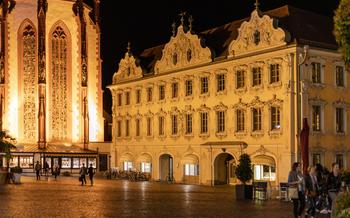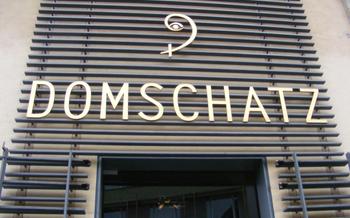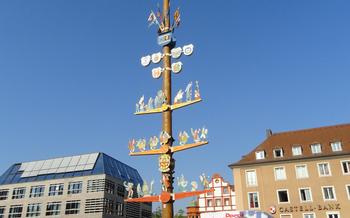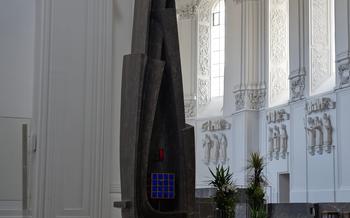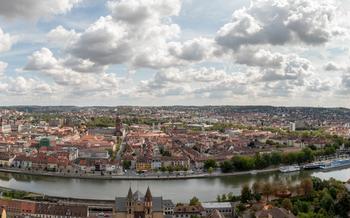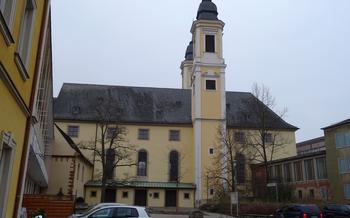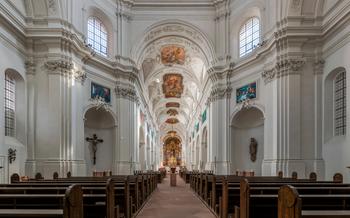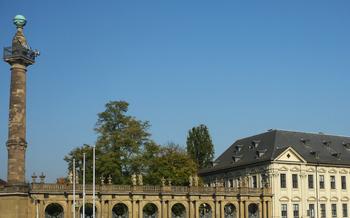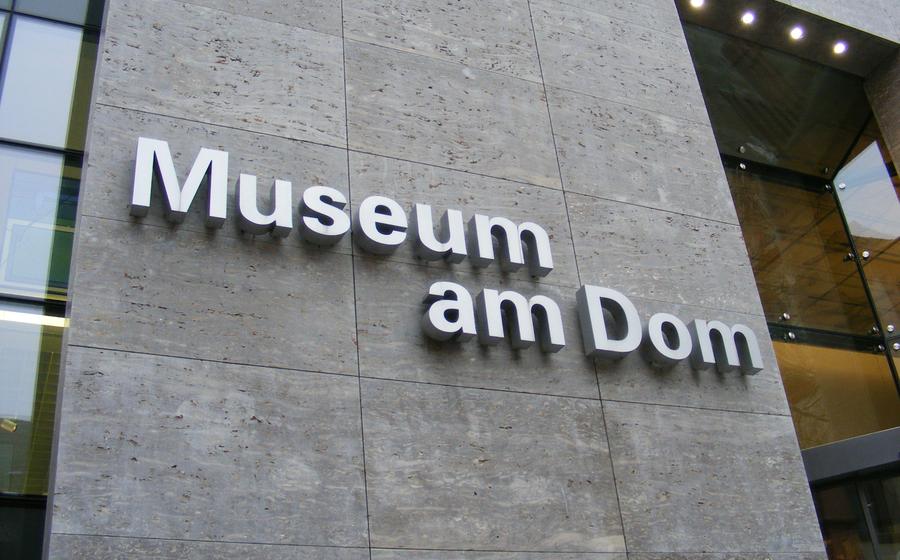
Museum am Dom
- Welcoming Würzburg's Antiquity
- A Cathedral Treasure Trove
- Preserving History at the Museum am Dom
- Medieval Masterpieces
- Beyond the Sculptures
- A Glimpse into Monastic Life
- Discovering the Cathedral's Secrets
- Engaging Educational Programs
- Special Exhibitions and Events
- Accessibility and Visitor Amenities
- Beyond the Museum Walls
- Culinary Delights
- Insider Tip: Unveiling the Cathedral's Hidden Gems
Welcoming Würzburg's Antiquity
Würzburg, a city steeped in history, invites visitors to delve into its rich past, dating back to the Stone Age. The region's earliest inhabitants left traces of their presence in the form of tools and artifacts, hinting at the vibrant life that thrived here even in prehistoric times. As centuries passed, Celtic tribes roamed the land, leaving their mark on the local culture and traditions. The arrival of the Roman Empire brought significant changes, with the establishment of military camps and the introduction of Roman customs and infrastructure. In 741, Würzburg underwent a profound transformation, becoming a Bishopric under the leadership of Saint Burchard. This pivotal event laid the foundation for the city's religious significance and set the stage for its future growth and development.
A Cathedral Treasure Trove
Würzburg's awe-inspiring Cathedral, known as the Würzburger Dom, stands as a testament to the city's rich history and architectural prowess. Its origins can be traced back to the 8th century, when a small church was erected on the site. However, the present-day structure, a masterpiece of Romanesque architecture, took shape between 1040 and 122Constructed using sandstone quarried from the nearby Main River valley, the cathedral exudes an air of grandeur and solidity.
In the 15th century, the cathedral underwent extensive renovations, resulting in the addition of Gothic elements, such as the delicate tracery of the windows and the intricate carvings adorning the portals. The interior of the cathedral is a Baroque masterpiece, showcasing elaborate stucco work, vibrant frescoes, and gleaming gold accents. Among the many treasures housed within the cathedral are the exquisite sculptures of Tilman Riemenschneider, a renowned artist of the late Middle Ages and early Renaissance. His most famous works include the "Adam and Eve" figures, which display an astonishing level of detail and emotional depth.
Preserving History at the Museum am Dom
Established in 2012, the Museum am Dom is housed within the cloister of the former Neumünster Abbey, a significant architectural landmark in Würzburg. The museum serves as a guardian of the city's rich cultural and religious heritage, showcasing an array of artifacts from the Würzburg Cathedral and the surrounding diocese. Its mission is to provide visitors with a comprehensive understanding of the region's profound history and its enduring influence on the present.
The museum's collection encompasses a diverse range of objects, including sculptures, paintings, liturgical items, and everyday artifacts. These treasures offer a tangible connection to the past, providing insights into the lives and beliefs of the people who shaped Würzburg's unique identity. Through its exhibits, the Museum am Dom invites visitors to embark on a journey through time, exploring the evolution of the city from its humble beginnings to its status as a thriving cultural and religious center.
Medieval Masterpieces
Among the treasures of the Museum am Dom, the works of Tilman Riemenschneider stand out as true masterpieces. This renowned sculptor, born in Würzburg in 1460, left an indelible mark on the artistic landscape of the region. His exquisite sculptures, carved with meticulous precision and infused with deep emotion, are a testament to his genius.
Riemenschneider's "Adam and Eve" figures, created around 1495, are among the highlights of the museum's collection. These life-size sculptures, carved from linden wood, capture the essence of human nature with remarkable realism. The intricate details of their anatomy, the subtle expressions on their faces, and the graceful poses create a sense of intimacy and connection with the viewer.
Riemenschneider's works are not merely technical marvels but also profound reflections on the human condition. His sculptures often convey themes of faith, redemption, and the complexities of human emotions. The artist's ability to imbue his subjects with such depth and emotion has earned him a place among the greatest masters of the German Renaissance.
Beyond the Sculptures
The Museum am Dom boasts an impressive collection that extends beyond the remarkable works of Tilman Riemenschneider. Among the notable pieces is the "Würzburg Madonna," a stunning sculpture dating back to the 14th century. Crafted with exceptional detail and grace, this wooden figure portrays the Virgin Mary with a serene expression, holding the infant Jesus in her arms.
Another highlight is the "Crucifixion Group" by Hans Backoffen, created in the 15th century. This poignant work depicts the crucifixion of Jesus Christ, capturing the emotions and suffering of the central figures. The intricate carvings and expressive details add depth and realism to the scene.
The museum also houses the "St. Kilian's Shrine," an elaborate piece from the 18th century. Dedicated to the patron saint of Würzburg, St. Kilian, this ornate shrine showcases intricate metalwork and colorful enamel. The shrine serves as a testament to the region's rich religious heritage and craftsmanship.
A Glimpse into Monastic Life
The Museum am Dom also sheds light on the intriguing world of the monks who once resided within the walls of the Neumünster Abbey. Through a captivating display of artifacts, visitors gain insights into their daily routines, rituals, and contributions to the community. Liturgical objects, such as chalices, vestments, and prayer books, provide a glimpse into the spiritual and ceremonial aspects of monastic life. Furthermore, the museum showcases the monks' involvement in various activities, including farming, brewing, and the production of manuscripts, highlighting their multifaceted role in shaping the cultural and economic landscape of Würzburg.
Discovering the Cathedral's Secrets
Beyond showcasing the artistic treasures, the Museum am Dom delves into the intricate details of the Würzburg Cathedral's construction and renovation. Through engaging exhibits, visitors can embark on a journey of discovery, learning about the architectural techniques, materials, and challenges faced by the master builders. Detailed models, plans, and historical documents provide a glimpse into the cathedral's enduring legacy, shedding light on the creative vision and engineering prowess that brought this architectural masterpiece to life.
The museum's exhibits highlight the various stages of the cathedral's construction, from its Romanesque origins to its Gothic transformation and Baroque embellishments. Visitors can trace the evolution of the building's design, marvel at the innovative solutions employed to overcome structural obstacles, and appreciate the meticulous craftsmanship that went into every aspect of its construction.
Furthermore, the museum offers insights into the ongoing efforts to preserve and restore the cathedral. Interactive displays showcase the techniques used to repair and maintain the building's exterior and interior, ensuring that this architectural gem continues to stand as a testament to human ingenuity and devotion.
Engaging Educational Programs
The Museum am Dom is committed to providing educational opportunities for visitors of all ages. Guided tours are available in German and English, offering a deeper insight into the museum's collection and the history of Würzburg. The tours are led by knowledgeable guides who bring the exhibits to life with their stories and explanations.
For school groups, the museum offers tailored programs that align with different grade levels and curricula. These programs use interactive activities and hands-on experiences to engage students with the past. Workshops and educational events are also organized throughout the year, providing opportunities for participants to explore specific themes or techniques in greater depth.
Through its educational initiatives, the Museum am Dom aims to foster a love of history and culture, inspire creativity, and encourage critical thinking. The museum's commitment to education ensures that visitors of all ages can learn from and appreciate the rich heritage of Würzburg.
Special Exhibitions and Events
The Museum am Dom enriches its offerings with a dynamic program of temporary exhibitions, showcasing specific themes, artists, or periods in history. These exhibitions provide visitors with a deeper dive into various aspects of art, culture, and religious heritage. The museum collaborates with other institutions and museums to bring diverse perspectives and expertise to its exhibitions.
In addition to exhibitions, the Museum am Dom hosts a range of cultural events, lectures, and concerts throughout the year. These events offer visitors opportunities to engage with experts, learn about different topics, and experience the museum in new and exciting ways. From intimate lectures on art history to captivating concerts featuring local musicians, there's always something to discover at the Museum am Dom.
Accessibility and Visitor Amenities
The Museum am Dom is committed to providing an accessible and welcoming environment for all visitors. Wheelchair accessible spaces and elevators ensure that everyone can explore the museum's exhibits comfortably. Clear signage and multilingual audio guides assist visitors in navigating the museum and learning about its collections. A museum shop offers a variety of souvenirs and publications, allowing visitors to take a piece of their experience home with them.
Beyond the Museum Walls
Würzburg's cultural tapestry extends beyond the Museum am Dom. The city boasts a wealth of historical and architectural gems waiting to be explored. A short stroll from the museum, visitors can marvel at the Marienkapelle, a Gothic masterpiece with its intricate stone carvings and stained glass windows. The Alte Mainbrücke, the city's iconic bridge, offers breathtaking views of the river and the surrounding cityscape. Perched on a hilltop, the Fortress Marienberg stands as a testament to Würzburg's rich past, showcasing stunning fortifications and panoramic vistas.
For those seeking a deeper immersion into history and art, the Residenz, a UNESCO World Heritage Site, is a must-visit. This magnificent palace, once home to the prince-bishops of Würzburg, boasts opulent halls, lavish gardens, and a world-renowned collection of paintings, sculptures, and tapestries.
Würzburg is also renowned for its vibrant cultural scene. The city hosts the annual Franconian Wine Festival, a celebration of the region's winemaking traditions, featuring wine tastings, parades, and traditional music. Throughout the year, visitors can enjoy a variety of cultural events, including theater performances, concerts, and art exhibitions.
Culinary Delights
Würzburg's culinary scene offers a tantalizing blend of traditional Franconian flavors and modern gastronomic delights. Indulge in the city's signature dish, Bratwurst, a succulent grilled sausage often served with sauerkraut and mashed potatoes. Another local delicacy is Schäufele, a slow-roasted pork shoulder that melts in your mouth. Pair your meal with a glass of wine from the region's renowned vineyards. Franconian wines, particularly the Silvaner and Riesling varieties, are celebrated for their crispness and fruity notes. To fully immerse yourself in the local culinary culture, visit a traditional restaurant or wine tavern. These cozy establishments offer a warm ambiance and a chance to savor authentic Franconian dishes, often accompanied by live music and friendly conversation. Don't miss the opportunity to embark on a wine tasting tour in the surrounding vineyards, where you can sample a variety of vintages while admiring the picturesque landscapes.
Insider Tip: Unveiling the Cathedral's Hidden Gems
Beyond the museum's walls, the Würzburg Cathedral itself holds hidden treasures waiting to be discovered. Take a moment to wander through the serene cloister garden, a tranquil oasis amidst the city's bustle. Admire the intricate carvings and sculptures adorning the cathedral's exterior, each telling a story from its rich history.
Delve deeper into the cathedral's opulence by visiting the Domschatzkammer (Cathedral Treasury). Here, marvel at a dazzling array of ecclesiastical artifacts, including precious reliquaries, ornate vestments, and shimmering goldsmith work. The treasury offers a glimpse into the wealth and artistry that once adorned the cathedral's ceremonies.
To fully immerse yourself in the cathedral's spiritual essence, consider attending a special service or concert held within its hallowed halls. The acoustics of the cathedral are renowned for their clarity and resonance, promising an unforgettable auditory experience. Whether you're a music lover or a seeker of spiritual enlightenment, these events offer a unique opportunity to connect with the cathedral's enduring legacy.
